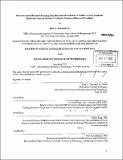| dc.contributor.advisor | T. (Teo) Forcht Dagi and Jeffrey Karp. | en_US |
| dc.contributor.author | Truesdell, John A., Jr. (John Alan) | en_US |
| dc.contributor.other | Harvard University--MIT Division of Health Sciences and Technology. | en_US |
| dc.date.accessioned | 2012-01-12T19:30:18Z | |
| dc.date.available | 2012-01-12T19:30:18Z | |
| dc.date.copyright | 2011 | en_US |
| dc.date.issued | 2011 | en_US |
| dc.identifier.uri | http://hdl.handle.net/1721.1/68470 | |
| dc.description | Thesis (S.M.)--Harvard-MIT Division of Health Sciences and Technology, 2011. | en_US |
| dc.description | Cataloged from PDF version of thesis. | en_US |
| dc.description | Includes bibliographical references (p. 50-51). | en_US |
| dc.description.abstract | The National Institutes of Health (NIH) has been the stalwart of research funding at universities and academic teaching hospitals. However, since the start of the last decade NIH funding has contracted in real terms. Anticipating future Federal Government fiscal austerity, the situation appears unlikely to improve and most likely will become worse. Local area teaching hospitals have explored other funding to support their large research infrastructure such as industry-sponsored research. This thesis qualitatively assessed whether the Federal Government and local area academic hospital fiscal data over the last six years support the hypothesis: Yes, industry funding has been received to support research at local area teaching hospitals to substitute for decreased availability of NIH funds. To test the hypothesis, Federal and local hospital fiscal data were extracted and statistical analysis was performed in three key areas to challenge the hypothesis and eliminate confounding data. First, is National Institutes of Health funding decreasing in real terms? Second, have local area teaching hospitals compensated by soliciting and receiving greater levels of industry sponsored research dollars? Third, has industry increased support in light of decreased NIH funding or are industry research commitments uncorrelated? The test questions were evaluated across two different hospitals and against various economic benchmarks. The hypothesis was rejected. Decreased NIH research funding granted to local academic hospitals has not caused a corresponding increase in industry sponsored research funding. Given the structural difficulties of industry and academic hospital collaboration, this likely impacts the level of industry sponsored research funding. Unfortunately, upcoming long-term Federal fiscal austerity may severely curtail NIH budgets. Academic hospitals will either need to consider greater industry collaboration or reduce the size and scope of their research activities. | en_US |
| dc.description.statementofresponsibility | by John A. Truesdell, Jr. | en_US |
| dc.format.extent | 51 p. | en_US |
| dc.language.iso | eng | en_US |
| dc.publisher | Massachusetts Institute of Technology | en_US |
| dc.rights | M.I.T. theses are protected by
copyright. They may be viewed from this source for any purpose, but
reproduction or distribution in any format is prohibited without written
permission. See provided URL for inquiries about permission. | en_US |
| dc.rights.uri | http://dspace.mit.edu/handle/1721.1/7582 | en_US |
| dc.subject | Harvard University--MIT Division of Health Sciences and Technology. | en_US |
| dc.title | Does decreased research funding from the National Institutes of Health to local academic hospitals cause an increase in industry sponsored research funding? | en_US |
| dc.type | Thesis | en_US |
| dc.description.degree | S.M. | en_US |
| dc.contributor.department | Harvard University--MIT Division of Health Sciences and Technology | |
| dc.identifier.oclc | 769909583 | en_US |
